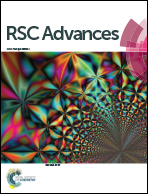A fast and selective probe for detection of CN− and F− in water along with a sequential molecular logic circuit via resettable optical readout†
Abstract
A Fe(II)-terpyridyl based optical probe has been developed for the detection of CN− and F− at ppm levels which potentially meets real-world-challenges through a simple synthetic route, water based activity, fast response, by-eye visualization, high selectivity and multiple readout for precise analysis. Its stimuli-responsive optical properties have been utilised to design molecular logic circuits and keypad locks.


 Please wait while we load your content...
Please wait while we load your content...